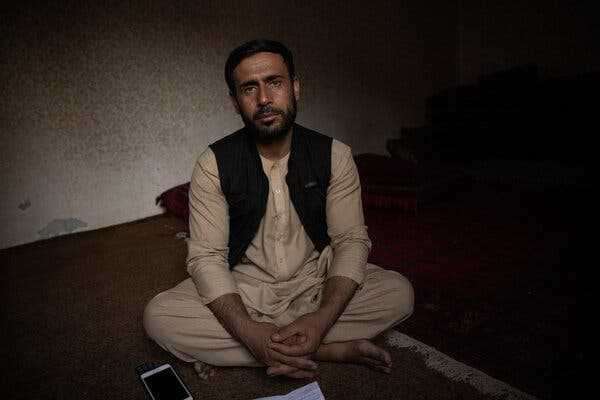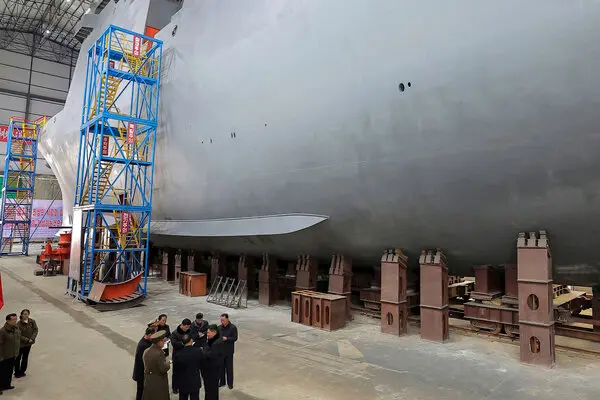Nearly a year after the strike that killed 10 civilians, more than 30 people the Biden administration pledged to help resettle in the U.S. are still trying to leave the country.
-
Send any friend a story
As a subscriber, you have “>10 gift articles to give each month. Anyone can read what you share.
Give this article
- Read in app

Emal Ahmadi is the brother of Zemari Ahmadi, who was killed in the drone strike in Kabul, Afghanistan, last year.
WASHINGTON — Soon after the U.S. military mistakenly killed 10 civilians, including seven children, last August in the final U.S. drone strike before American troops withdrew from Afghanistan, the Biden administration pledged to help surviving members of the family relocate to the United States for their safety.
Nearly a year later, fewer than a dozen of the 144 family members have been resettled in the United States and 32 people remain trapped in Afghanistan with little hope of getting out soon, advocates for the family said on Monday. The rest have been stuck for months in a diplomatic limbo after being taken to three countries to await screening to enter the United States.
The odyssey of the family members of Zemari Ahmadi, the driver of a white Toyota sedan that was struck by the American drone, and others employed by Mr. Ahmadi’s aid organization in Afghanistan is a saga of passport problems, bureaucratic red tape and Taliban capriciousness. On one day in June, for instance, 43 family members traveling overland were allowed to cross into Pakistan. The very next day, a similar group was turned back at the border after the Taliban imposed new travel-document rules.
Lawyers for the family members praised the efforts of the Pentagon and the State Department to help evacuate their clients, and said they had refrained from commenting publicly until now to protect their clients’ safety. But they said much more needed to be done and were now breaking their silence.
VideotranscriptBackbars0:00/11:02-0:00
transcript
How a U.S. Drone Strike Killed the Wrong Person
A week after a New York Times visual investigation, the U.S. military admitted to a tragic mistake in an Aug. 29 drone strike in Kabul that killed 10 civilians, including an aid worker and seven children.
[explosion] In one of the final acts of its 20-year war in Afghanistan, the United States fired a missile from a drone at a car in Kabul. It was parked in the courtyard of a home, and the explosion killed 10 people, including 43-year-old Zemari Ahmadi and seven children, according to his family. The Pentagon claimed that Ahmadi was a facilitator for the Islamic State, and that his car was packed with explosives, posing an imminent threat to U.S. troops guarding the evacuation at the Kabul airport. “The procedures were correctly followed, and it was a righteous strike.” What the military apparently didn’t know was that Ahmadi was a longtime aid worker, who colleagues and family members said spent the hours before he died running office errands, and ended his day by pulling up to his house. Soon after, his Toyota was hit with a 20-pound Hellfire missile. What was interpreted as the suspicious moves of a terrorist may have just been an average day in his life. And it’s possible that what the military saw Ahmadi loading into his car were water canisters he was bringing home to his family — not explosives. Using never-before seen security camera footage of Ahmadi, interviews with his family, co-workers and witnesses, we will piece together for the first time his movements in the hours before he was killed. Zemari Ahmadi was an electrical engineer by training. For 14 years, he had worked for the Kabul office of Nutrition and Education International. “NEI established a total of 11 soybean processing plants in Afghanistan.” It’s a California based NGO that fights malnutrition. On most days, he drove one of the company’s white Toyota corollas, taking his colleagues to and from work and distributing the NGO’s food to Afghans displaced by the war. Only three days before Ahmadi was killed, 13 U.S. troops and more than 170 Afghan civilians died in an Islamic State suicide attack at the airport. The military had given lower-level commanders the authority to order airstrikes earlier in the evacuation, and they were bracing for what they feared was another imminent attack. To reconstruct Ahmadi’s movements on Aug. 29, in the hours before he was killed, The Times pieced together the security camera footage from his office, with interviews with more than a dozen of Ahmadi’s colleagues and family members. Ahmadi appears to have left his home around 9 a.m. He then picked up a colleague and his boss’s laptop near his house. It’s around this time that the U.S. military claimed it observed a white sedan leaving an alleged Islamic State safehouse, around five kilometers northwest of the airport. That’s why the U.S. military said they tracked Ahmadi’s Corolla that day. They also said they intercepted communications from the safehouse, instructing the car to make several stops. But every colleague who rode with Ahmadi that day said what the military interpreted as a series of suspicious moves was just a typical day in his life. After Ahmadi picked up another colleague, the three stopped to get breakfast, and at 9:35 a.m., they arrived at the N.G.O.’s office. Later that morning, Ahmadi drove some of his co-workers to a Taliban-occupied police station to get permission for future food distribution at a new displacement camp. At around 2 p.m., Ahmadi and his colleagues returned to the office. The security camera footage we obtained from the office is crucial to understanding what happens next. The camera’s timestamp is off, but we went to the office and verified the time. We also matched an exact scene from the footage with a timestamp satellite image to confirm it was accurate. A 2:35 p.m., Ahmadi pulls out a hose, and then he and a co-worker fill empty containers with water. Earlier that morning, we saw Ahmadi bring these same empty plastic containers to the office. There was a water shortage in his neighborhood, his family said, so he regularly brought water home from the office. At around 3:38 p.m., a colleague moves Ahmadi’s car further into the driveway. A senior U.S. official told us that at roughly the same time, the military saw Ahmadi’s car pull into an unknown compound 8 to 12 kilometers southwest of the airport. That overlaps with the location of the NGO’s office, which we believe is what the military called an unknown compound. With the workday ending, an employee switched off the office generator and the feed from the camera ends. We don’t have footage of the moments that followed. But it’s at this time, the military said that its drone feed showed four men gingerly loading wrapped packages into the car. Officials said they couldn’t tell what was inside them. This footage from earlier in the day shows what the men said they were carrying — their laptops one in a plastic shopping bag. And the only things in the trunk, Ahmadi’s co-workers said, were the water containers. Ahmadi dropped each one of them off, then drove to his home in a dense neighborhood near the airport. He backed into the home’s small courtyard. Children surrounded the car, according to his brother. A U.S. official said the military feared the car would leave again, and go into an even more crowded street or to the airport itself. The drone operators, who hadn’t been watching Ahmadi’s home at all that day, quickly scanned the courtyard and said they saw only one adult male talking to the driver and no children. They decided this was the moment to strike. A U.S. official told us that the strike on Ahmadi’s car was conducted by an MQ-9 Reaper drone that fired a single Hellfire missile with a 20-pound warhead. We found remnants of the missile, which experts said matched a Hellfire at the scene of the attack. In the days after the attack, the Pentagon repeatedly claimed that the missile strike set off other explosions, and that these likely killed the civilians in the courtyard. “Significant secondary explosions from the targeted vehicle indicated the presence of a substantial amount of explosive material.” “Because there were secondary explosions, there’s a reasonable conclusion to be made that there was explosives in that vehicle.” But a senior military official later told us that it was only possible to probable that explosives in the car caused another blast. We gathered photos and videos of the scene taken by journalists and visited the courtyard multiple times. We shared the evidence with three weapons experts who said the damage was consistent with the impact of a Hellfire missile. They pointed to the small crater beneath Ahmadi’s car and the damage from the metal fragments of the warhead. This plastic melted as a result of a car fire triggered by the missile strike. All three experts also pointed out what was missing: any evidence of the large secondary explosions described by the Pentagon. No collapsed or blown-out walls, including next to the trunk with the alleged explosives. No sign that a second car parked in the courtyard was overturned by a large blast. No destroyed vegetation. All of this matches what eyewitnesses told us, that a single missile exploded and triggered a large fire. There is one final detail visible in the wreckage: containers identical to the ones that Ahmadi and his colleague filled with water and loaded into his trunk before heading home. Even though the military said the drone team watched the car for eight hours that day, a senior official also said they weren’t aware of any water containers. The Pentagon has not provided The Times with evidence of explosives in Ahmadi’s vehicle or shared what they say is the intelligence that linked him to the Islamic State. But the morning after the U.S. killed Ahmadi, the Islamic State did launch rockets at the airport from a residential area Ahmadi had driven through the previous day. And the vehicle they used … … was a white Toyota. The U.S. military has so far acknowledged only three civilian deaths from its strike, and says there is an investigation underway. They have also admitted to knowing nothing about Ahmadi before killing him, leading them to interpret the work of an engineer at a U.S. NGO as that of an Islamic State terrorist. Four days before Ahmadi was killed, his employer had applied for his family to receive refugee resettlement in the United States. At the time of the strike, they were still awaiting approval. Looking to the U.S. for protection, they instead became some of the last victims in America’s longest war. “Hi, I’m Evan, one of the producers on this story. Our latest visual investigation began with word on social media of an explosion near Kabul airport. It turned out that this was a U.S. drone strike, one of the final acts in the 20-year war in Afghanistan. Our goal was to fill in the gaps in the Pentagon’s version of events. We analyzed exclusive security camera footage, and combined it with eyewitness accounts and expert analysis of the strike aftermath. You can see more of our investigations by signing up for our newsletter.”

A week after a New York Times visual investigation, the U.S. military admitted to a tragic mistake in an Aug. 29 drone strike in Kabul that killed 10 civilians, including an aid worker and seven children.CreditCredit…By The New York Times. Video frame: Nutrition & Education International.
“As the anniversary of the strike approaches, the public needs to know that the government is failing to meet its promises, and our clients’ lives are in the United States’ hands,” said Brett Max Kaufman, a senior staff attorney for the American Civil Liberties Union, which is representing members of Mr. Ahmadi’s family as well as other employees of Nutrition & Education International, Mr. Ahmadi’s aid organization in Afghanistan.
Mr. Ahmadi’s family members and other employees of the aid organization the U.S. government agreed to evacuate are a small subset of the more than 120,000 Afghans who were airlifted after the Taliban seized control of the country last August, and the thousands who sought to flee but have so far failed.
Officials said the prospects for extracting the last 32 family members hiding in Afghanistan became more complicated after the C.I.A. two weeks ago killed Ayman al-Zawahri, the leader of Al Qaeda, while he was hiding out in a house in a crowded section of the Taliban-controlled Afghan capital.
“I remain increasingly scared for the people — including Zemari’s family members and our N.E.I. colleagues — who are still stuck in Afghanistan without any certainty or timeline to get out,” Steven Kwon, the founder and president of Nutrition & Education International, said in a statement.
“The U.S. government must keep its promise and get all those affected by its mistaken drone strike to safety before it’s too late,” Mr. Kwon said.
Pentagon officials said they had been working for months along with State Department and White House colleagues to evacuate the family members and other employees of the aid organization, despite no longer having any American military or diplomatic presence in Afghanistan.
“The Department of Defense, in coordination with other U.S. government departments and agencies, continues to take steps to respond to the Aug. 29, 2021, airstrike in Kabul, Afghanistan,” Todd Breasseale, the acting Pentagon press secretary, said in a statement. “To protect the privacy of the family members, as well as to help protect their safety and security, we are not able to provide more information regarding these efforts at this time,” Mr. Breasseale added.
Senior Defense Department officials and military commanders acknowledged soon after the drone strike that Mr. Ahmadi had nothing to do with the Islamic State, contrary to what military officials had previously asserted. Mr. Ahmadi’s only connection to the terrorist group appeared to be a fleeting and innocuous interaction with people in what the military believed was an Islamic State safe house in Kabul, an initial link that led military analysts to make one misjudgment after another while tracking Mr. Ahmadi’s movements in the sedan for the next eight hours.
In addition to resettlement in the United States, the Pentagon has offered unspecified condolence payments to family members. Administration officials and lawyers for the family said negotiations over any payments have been suspended until all family members have been safely evacuated from Afghanistan.
Congress has authorized the Pentagon to pay up to $3 million a year for payments to compensate for property damage, personal injury or deaths related to the actions of U.S. armed forces, as well as for “hero payments” to the family members of local allied forces, such as Afghan or Iraqi troops fighting Al Qaeda or ISIS.
Condolence payments for deaths caused by the American military have varied widely in recent years. In the 2019 fiscal year, for instance, the Pentagon offered 71 such payments — ranging from $131 to $35,000 — in Afghanistan and Iraq.
Almost everything senior defense officials asserted in the hours, days and weeks after the Aug. 29 drone strike turned out to be false. The explosives that the military claimed were loaded in the trunk of the sedan struck by the drone’s Hellfire missile were probably water bottles, and a secondary explosion in the courtyard in the densely populated Kabul neighborhood where the attack took place was probably a propane or gas tank, officials said.
Gen. Kenneth F. McKenzie Jr., the head of the military’s Central Command at the time, said in a news conference last September that the strike was carried out “in the profound belief” that the Islamic State was about to attack Hamid Karzai International Airport, as the organization had done three days earlier, killing about 170 civilians and 13 U.S. troops.
The acknowledgment of the mistaken strike came a week after a New York Times investigation of video evidence challenged assertions by the military that it had struck a vehicle carrying explosives meant for the airport.
Several weeks later, in November, Colin H. Kahl, the under secretary of defense for policy, offered the condolence payments and the help resettling to Mr. Kwon in a virtual meeting.
One of the first matters was to define the size of the group to receive the assistance. One group included immediate and extended family members of Mr. Ahmadi. A second group was made up of other employees of the aid organization and some of their family members. In all, 144 people — including a significant number of children — were identified as warranting assistance to leave the country for their safety, said Mr. Kaufman, the A.C.L.U. lawyer.
With no American personnel remaining in Afghanistan, the State Department hired a contractor to help feed, clothe and shelter the family members while U.S. officials sought to arrange flights or other means for the Afghans to leave the country.
The group faced stumbling blocks right away. Many of the individuals had no passports or other travel documents that the Taliban and receiving countries would accept. Commercial flights in and out of the country were sporadic. Two elderly relatives died during the waiting period.
But slowly, the line of family members began to move. Most flew directly to one of three countries — Albania, Kosovo or Qatar — where, like many other Afghan refugees, they received medical care and security processing as refugees. Some joined a convoy and drove out of the country into Pakistan, and on to one of the transit countries.
The first family members arrived in the United States in May, with others coming in July. In all, 11 family members have resettled in three states, which Mr. Kaufman did not identify for security reasons.
“That some members of Zemari’s family have begun to pick up the pieces of their lives with a new start in America is undoubtedly good news,” Mr. Kaufman said. “But the bottom line is that the government has not done enough, and many of our clients remain in danger.”
Source: nytimes.com



